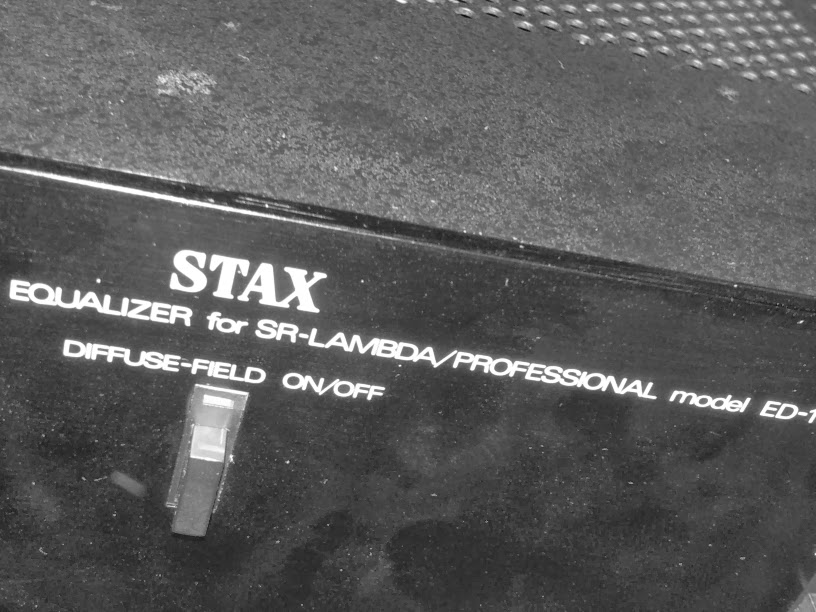Disclaimer: I can finally give a proper introduction to this classic masterpiece, thanks to my good friend, vAsurada, who resides in South Korea. This article would have never been publicized had he not given me permission to do so.
Introduction
As previously mentioned, STAX's ED-1 Monitor is a proprietary equalizer module specially designed for their SR-Λ Pro. With the help of the module, the headphone is effectively turned into the most accurate diffuse-field simulator ever created in the history of headphones.
ED-1's creation goes way back. In 1985, Dr. Günther Theile of IRT(Institut fur Rundfunktechnik) comes up with a revolutionary idea that challenges the common notion of free-field equalization, and thus changes the history of headphones forever. By assessing the data acquired physically, such as by using actual human ears, he argues that the localization characteristic of headphones is close to that of a diffuse-field, rather than that of a free-field.
Theile explains the functional goal of a diffuse-field reference in his IRT article:
"various quality assessment tests have confirmed that a flat diffuse-field sensitivity curve of a headphone is a guarantee of optimum sound neutrality. Headphones with exact IRT equalization are now being manufactured by various companies."
This is what the manufacturer, STAX, has to say about the equalizer:
"The ED-1 equalizer began as a project for Munich's Institute of Broadcast Technique, to fulfill the demand for an SR-Lambda Pro capable of monitoring binaural radio plays and delivering diffuse-field response for experiments. Measuring headphone frequency response meaningfully has proved difficult; this new approach, involving the insertion of probe microphones into the ear canals of different human subjects, produces data which correlates better with what one actually hears than did the old free-field tests. Simply put, the goal is to achieve flat response at the eardrum, not at the entrance to the ear. The ED-1 can be switched into and out of the signal path from the front panel, so its effect is easy to judge."Although the equalizer is a proprietary design for SR-Λ Pro, almost all of STAX's headphones are well compatible with the module too. Here is the list of the ED-1 compatible models that have been previously analyzed on this blog: SR-003, SR-207, SR-Λ Pro/Signature/Nova Basic, and SR-009.
Frequency response & Phase
Time Domain
The absolute polarity is inverted with the equalizer. STAX users must pay attention to this detail as SR-Λ Pro is one of the few headphones from STAX with aligned polarity.
Distortion
THD
SMPTE IMD(60Hz, 7kHz / 1:4): 0.0024% (relative)
THD+N(A): 0.0013% (relative)
Clearly, the amount of distortion ED-1 introduces to the entire playback chain is negligible.
Conclusion
It seems that the idea of utilizing a perfect diffuse-field target is now abandoned, and as a new trend, more manufacturers are incorporating a negatively sloped diffuse-field target. In addition, by investigating the listener preference among headphone users, headphone acoustics will keep advancing forward, further distancing itself away from the principle that STAX have once sought with their ED-1.
However, STAX must be glorified as no other headphone manufacturers have ever created a proprietary equalizer of such quality solely to optimize the sound itself. The legacy ED-1 bears is timeless, and the effort the engineers have devoted in designing the module shall be remembered forever.
References
G. Theile, "The Importance of Diffuse-field Equalization for Stereophonic Recording and Reproduction," 13. Tonmeistertagung München, 1984.
STAX. Fifty Years of Excellence. 940 East Dominguez St., Carson, CA 90746: STAX, 1988. Print.







I love STAX and even more love STAX with ED-1 :) ED-1 makes vocal more vivid and realistic. It is necessery for SR-Lambda users, not an option. It is not needed for every music, but many musics are turned on more attractive.
ReplyDeletethis is very brilliant, thanks for sharing.
ReplyDeletevideo korporat
rancangan perniagaan
printing logo